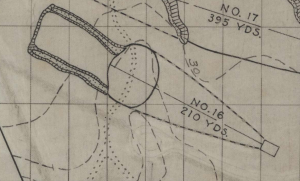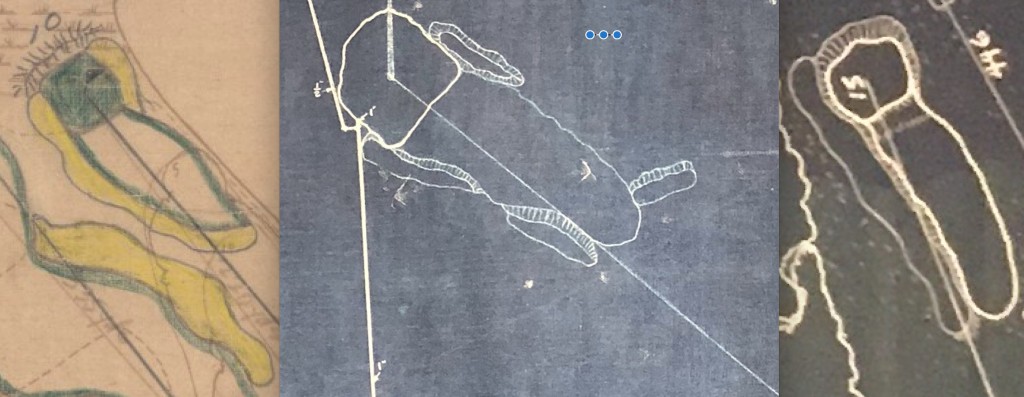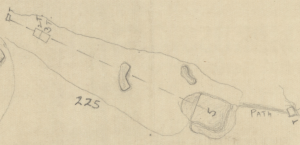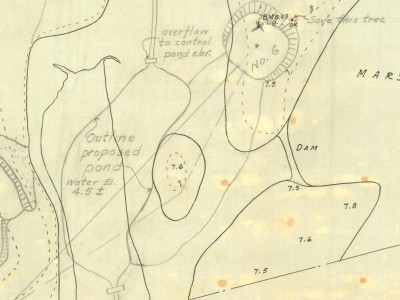By Anthony Pioppi
The universal thought among those even slightly knowledgeable in the work of golf architects Charles Blair Macdonald, Seth Raynor and Charles Banks is that they designed four styles of par-3s that were used throughout their careers.
The four, based on holes of the British Isles and France, are part of the collection of Ideal Golf Holes on which Macdonald, and subsequently Raynor and Banks, modeled most of their par-3s.
Those are the Short at around 140 yards to the middle of the green, the Eden is usually about 165 yards, the Redan is at 190 yards or so and the Biarritz hole usually plays around 215 yards.
There is, though, a fifth par-3 design which I believe should be classified as an Ideal Hole. It appeared on at least six courses designed by Raynor, three by Macdonald and possibly one by Banks.
In the intervening years, the originals have caused much consternation, confusion and questioning. They have been referred to as One-Tier Biarritz by some. Others surmised the designs were a mistake made during construction. Others thought the clubs rejected the Biarritz concept and designed their own long par-3. All of those theories are wrong. The holes were not created on the ground and were not mistakes. Drawings of this style appear in plans for multiple layouts. This was a design that passed Macdonald’s rigid test for what makes a sound golf hole.
This until-now unrecognized Ideal hole is or was found at Brookville Country Club, Country Club of Charleston, Dedham Golf and Polo Club, Essex County Country Club, Gibson Island, Midland Hills, Morris County Golf Club, Mountain Lake and Sleepy Hollow, Southampton Golf Club and at the 27-hole Coral Keys, which only ever existed on paper. Sleepy Hollow would have been the debut. The course officially opened in 1913. The original Macdonald Biarritz was at Piping Rock which opened in 1912.
Raynor’s first version was at Mountain Lake. It appears on a plan dated to late 1916 and was playable in 1917.
Three courses, Dedham, Mountain Lake and Southampton, all had their versions converted to a Biarritz design. The three revisions were done by architect Brian Silva. Dedham and Southampton requested the alteration. When Silva redid the Mountain Lake hole the only original features remaining were the locations of the tees and green.

The Version at Yeamans Hall shows a green complex the size of which normally could be associated with a Biarritz green, but this one lacks a swale.
The basic premise of this “new” Ideal par-3 is that it plays the same length as a Biarritz, roughly between 215 yards and 225 yards, but lacks the tier and swale in front of the green. In most cases, the green of this style appears to be the size of the green proper on a Biarritz, that is the tier behind the swale. The outlier is the 16th at Yeamans. No swale is indicated on the drawing but the green complex appears to have the same size as an entire Biarritz complex, including the front plateau that was always mowed at fairway height when they were built.
Some versions of this hole require carrying a hazard to reach the green, others do not. Some bunkers are placed right before the green as at Southampton and Dedham, in other cases they are set well back as with Mountain Lake, and Essex.
Versions have strip bunkers on both sides of the green. There are those that have bunkering down only one side. Charleston’s green has no sand features and none were indicated on the original drawing.
All the greens appear to sit above the surrounding grade.
The triad of extremely similar design, a subset, was or is at Gibson Island (Macdonald), Midland and Essex County (both Raynor).

The three with a distinctly similar design, from left, Gibson Island, Midland Hills, Essex Country Club.
For those versions, a long bunker starting at the left side of the of the green extended down the left of the hole. At Gibson, it began at the back of the putting surface and continued for almost a hundred yards before curving across the fairway.
Except that the bunker does not bend, the Essex version is the same.
At Midland, the lone bunker is broken into two, starts at the left front of the green and does not arc. Midland also has a bunker at the right front of the fairway and right front of the green. At Gibson, a bunker on the right parallels the entire green. Essex has no other sand hazard at the right of the green but the land on that side falls off sharply.
The obvious question is why is there a second style of the longest par-3 that Raynor, Macdonald and Banks designed? Perhaps it was considered a less difficult hole than the Biarritz, which is an exceedingly testing design requiring a long, accurate carry to a heavily guarded green. When Macdonald and Raynor were building their versions, the tee shot for the average golfer would commonly be made with a driver or brassie (2-wood). If played correctly, the ball would land on the approach level, bound forward, find its way down into a swale as much as five feet deep in the case of the Yale Golf Course, disappearing, then reappearing and coming to rest on the back plateau where the putting surface was located.
A tee ball that stopped on the front tier left a testing chip shot over the swale. A chip or a putt from the swale was no bargain.
Perhaps this swale-less design played slightly easier and/or appeared less daunting from the tee.
Another question is what did they call this style? Some scorecards from the era still give it a Biarritz moniker, perhaps indicating the features that defined the hole were its length and green surface contouring and not the swale.
Whatever the reason for this style it was part of the pallet of Raynor, Macdonald and Banks and deserves a spot in the Ideal Golf Hole classification.
(The Mountain Lake, Charleston, Yeamans Hall and Gibson Island drawings courtesy of the United States Department of the Interior, National Park Serve, Frederick Law Olmsted National Historic Site.)


